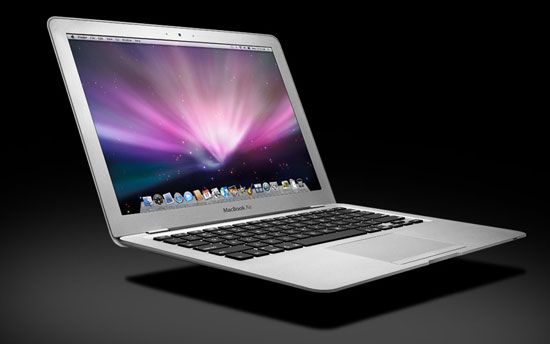Apple's MacBook Air: Uncovering Intel's Custom CPU for Apple
by Anand Lal Shimpi on January 15, 2008 12:00 AM EST- Posted in
- Mac
Apple just announced its MacBook Air and the thing looks stunning. If you haven’t already seen the specs, here’s what we’re looking at:
3 lbs
0.16” - 0.76” x 12.8” x 8.94” (H x W x D)
Full Size keyboard from the MacBook
13.3” 1280 x 800 LED backlit screen
2GB DDR2-667
Intel Core 2 Duo 1.6GHz or 1.8GHz, 800MHz FSB, 4MB shared L2
80GB 1.8” 4200RPM HDD or optional 64GB SSD
802.11n/Bluetooth 2.1+EDR
Starting at $1799
The MacBook Air looks to be a very well designed ultra portable, making very few compromises (no optical drive, but you get a full sized keyboard) while keeping the size down.

One feature that stood out from Steve’s announcement of the Air was that it appears to use a low-voltage Merom based Core 2 Duo instead of an Ultra Low Voltage Merom like most of its competitors.
Standard Merom (65nm) based Core 2 Duo processors run off of a 1.0375 - 1.3000V core voltage under normal operating conditions (full clock frequency). These chips range from 1.8GHz all the way up to 2.6GHz (not including Extreme Edition parts).
Low Voltage Core 2 Duo processors are lower yielding parts that can work at lower voltages, and thus Intel charges a small premium for these chips since they aren’t as common. These LV Core 2 Duos run at 0.9V - 1.2000V under normal operating conditions, and they are available in 1.4GHz, 1.6GHz and 1.8GHz speeds. We believe that these are the cores Apple is using in the MacBook Air.
Ultra Low Voltage Core 2 Duos drop operating voltage even lower, down to 0.8V - 0.975V, but clock speeds are limited to 1.06 - 1.33GHz. Mobile Penryn will eventually be offered in a ULV version, at which point we expect clock speeds to jump a bit but not enough for Apple’s needs.
Apple wanted the MacBook Air to be no-compromises, and thus the LV Core 2 Duo made the most sense. Mobile Penryn would’ve actually made even more sense, since the move to 45nm not only increases battery life but reduces thermal output; unfortunately there are no Low Voltage versions of the new core, not to mention that availability is extremely limited.
So with relative certainty we know what CPU core Apple is using in the MacBook Pro (there is no 4MB L2 Penryn and Intel wouldn’t spin a new version of a CPU just for Apple so we’re dealing with a 65nm Merom), but the bigger question is one of packaging size.










54 Comments
View All Comments
Zoomer - Tuesday, January 15, 2008 - link
Wireless is completely useless when sshing to another system remotely, in even moderate traffic settings.Draft-n approaching 100 Mbps ethernet? Dream on; it'll be great if it gets even half that.
JarredWalton - Tuesday, January 15, 2008 - link
The best I've seen in my laptop testing is around 7.5MBps of real throughput. That works out to 60Mbps - so better than 802.11g theoretical maximum, but still about 2/3 the speed of 100Mbit Ethernet. (Note also that many 802.11n chips seem to get more like 4-5MBps average rates, in ideal circumstances.) Now, go use any decent laptop these days and you get Gigabit, with speeds of around 40MBps easily achievable (the bottleneck generally being the hard drive(s) involved in transfers).yyrkoon - Wednesday, January 16, 2008 - link
7.5MB/s really is not that terrible compared to fast ethernet. Fast ethernet typically only gets 6-9MB/s from windows to windows transfers(standard file sharing), and I've personally seen 10MB/s with Linux -> Windows with Samba, and 11.4MB/s with Linux -> Windows iSCSI.GbE on the other hand really does not get much more than 30MB/s sustained for long periods of time. It has nothing really to do so much with the HDDs speeds as the disk block size vs TCP/IP packet sizes, and conversion. This of course would be on the garden variety home user type hardware, and laptop hardware should not be any better, or probably even as good. The new Windows Vista + TCP/IP stack etc, is purportedly supposed to fix this issue, but I guess we'll have to wait and see, because from what I understand it is still a work in progress.
Still, your point is made; GbE > 802.11n concerning transfers, although, if you didn't need security, firewire networking would do pretty well . . .
Anyhow for a Portable PC, I think I would rather have a modded Asus Eee, with a 80GB HDD in it. Something for mobile media files, and to have something on hand to upload RAW images to from my DSLR. Then again, I am not much for mobile system, except for what they can help me with while I am away from my desktop.
However, If I were working in the wireless internet business, etc, and needed to have a PC on a rooftop with me while aligning an antenna or something, then the Mac Air would probably be the last laptop on the planet I'd need/want.
Blauhung - Tuesday, January 15, 2008 - link
It probably has intel's draft N wireless on board which is faster then what most people have for ethernet.